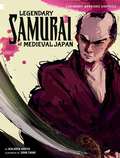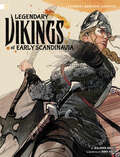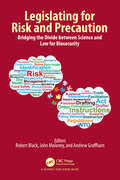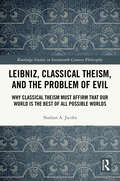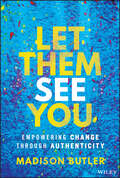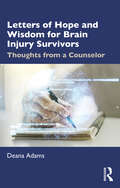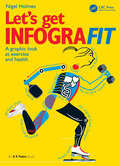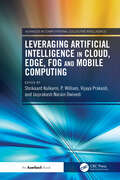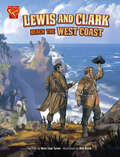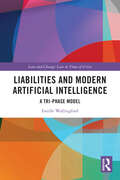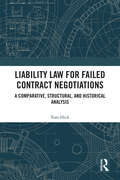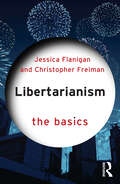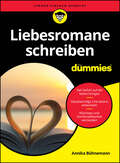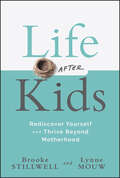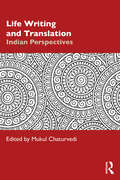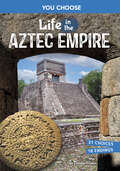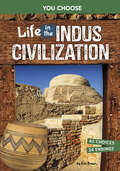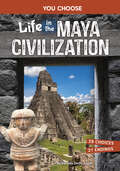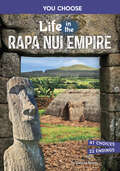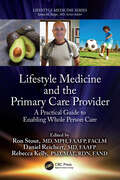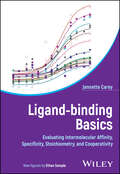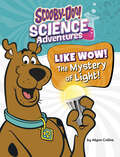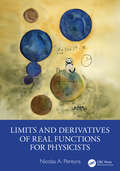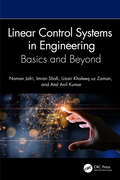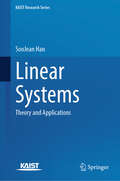- Table View
- List View
Legendary Samurai of Medieval Japan
by Benjamin HarperHonor. Loyalty. Mastery. The samurai were medieval Japan’s most elite warriors, sworn to serve their lords and protect their lands. Living by a strict code, they trained in deadly swordsmanship, archery, and strategy, mastering combat skills that made them nearly unstoppable on the battlefield. With high-energy illustrations and gripping text, this action-packed graphic novel takes readers into the world of history’s most legendary fighters.
Legendary Vikings of Early Scandinavia
by Benjamin HarperRaiders. Warriors. Explorers. The Vikings of ancient Scandinavia struck fear into the hearts of their enemies as they set sail in their dragon-headed longships. With battle axes in hand, these fearless fighters raided coastal villages, conquered new lands, and forged an empire that stretched from North America to Russia. But they weren’t just warriors; they were traders, shipbuilders, and storytellers whose influence still endures today. With high-energy illustrations and gripping text, this action-packed graphic novel explores the world of the Viking warriors who changed history forever.
Legislating for Risk and Precaution: Bridging the Divide between Science and Law for Biosecurity
by Robert Black John Moloney Andrew GraffhamThis book aims to demystify the law for scientists and instructing officials by exploring the science and legal concepts of risk and precaution for national legislation to facilitate safe trade in agricultural products (in compliance with international trade rules).The book is not meant to supplant the many authoritative titles on legislative drafting, but provide some practical exercises on instructions and drafting for this area of law. The book also includes some important factors in legal reform, such as the audience for and access to legislation. It, therefore, has the potential to be a valuable resource for coordinated training of instructors and drafters by helping to secure a robust two-way dialogue between them.
Leibniz, Classical Theism, and the Problem of Evil: Why Classical Theism Must Affirm That Our World is the Best of All Possible Worlds (Routledge Studies in Seventeenth-Century Philosophy)
by Nathan A. JacobsThis volume offers a defense of Leibniz’s theodicy and his infamous claim that our world is the best of all possible worlds. It considers Leibniz’s rationale for “optimism,” examines its roots in ancient and medieval thought, and forwards a novel rereading of Leibniz’s theory of freedom in light of this background, all of which highlights the very real challenges of evading optimism from within the framework of classical theism. Gottfried Leibniz is known for his “theodicy,” or defense of God's Goodness, Wisdom, and Justice despite the realities of evil in our world. This book argues that Leibniz’s optimism is inevitable for proponents of classical theism and even for many not-so-classical theists. The author’s argument is threefold. First, he demonstrates that Leibniz's theodicy is deeply rooted in the classical theist tradition, pagan and Christian, and shows that the philosopher of Leipzig is merely following these commitments to their logical conclusion, a conclusion that long precedes Leibniz. Second, he offers a novel rereading of Leibniz in the light of his philosophical and theological antecedents, a reading that, if correct, dispels ubiquitous but problematic assumptions about Leibniz's case, specifically those about divine and human freedom. Third, he demonstrates the analytic tether that connects classical theism to Leibniz’s conclusion, making his notorious optimism virtually inevitable for proponents of classical theism — and even for not-so-classical theists. This book demonstrates the ways in which Leibniz is relevant to not only classical theists and students of Modern philosophy but also to contemporary philosophers of religion more generally and philosophical theologians who are concerned with the problem of evil. Leibniz, Classical Theism, and the Problem of Evil will appeal to scholars and graduate students interested in Leibniz, philosophy of religion, history of philosophy, philosophical theology, free will, and the problem of evil.
Let Them See You: Empowering Change Through Authenticity
by Madison ButlerA deeply insightful and hands-on treatment of authenticity in the workplace and in the community In Let Them See You: Empowering Change Through Authenticity, mental health advocate and People Operations expert Madison Butler delivers an eye-opening and practical playbook for what it means to create safe spaces not just for others, but for yourself. You’ll learn what authenticity really looks like as you discover how to be authentic with yourself and with the world around you. The author will help you uncover who you are, and what you need in order to be safe space first to yourself and then to others. The book walks you through the micro- and macro-traumas that impact how you show up at home, at work, in your community, and everywhere else, every day. It unpacks the heartbreak, fear, and trauma experienced by members of every community, and gives you strategies for understanding people as they really are, bruises and all. Inside the book: A realistic and empathetic look at authenticity that takes into account the complexity of the human experience Strategies for acknowledging the myriad experiences, viewpoints, and perspectives of all people A focus on reality over unwarranted what it means to acknowledge your reality, while still speaking kindly to yourself. Perfect for managers, business leaders, and people in general, Let Them See You is a can’t-miss book for human resources practitioners, managers, business owners, and anyone else with an interest in enriching their understanding of what it means to demonstrate—and appreciate—authenticity.
Letters of Hope and Wisdom for Brain Injury Survivors: Thoughts from a Counselor
by Deana AdamsLetters of Hope and Wisdom for Brain Injury Survivors: Thoughts from a Counselor offers a personal, informal and spiritual perspective on how to manage the multiple issues related to brain injury. Written by a counsellor who draws on first hand experiential testimonies and insights, each chapter offers a personal letter to the survivor addressing the various issues stemming from a brain injury, along with practical applications suggested for recovery.The book offers a general overview of brain injury and how each part of the brain may be affected. Mental health issues such as depression, anxiety, anger, fear, post-traumatic stress, and grief are described from the perspectives of both the survivor and the family members, and the book also includes strategies on improving self-esteem and gaining new purpose after a brain injury. Additionally, practical coping skills are explained such as how to deal with sensory overload, adjusting the pace of life, and managing family events. Each chapter also offers a homework section that gives the reader additional exercises to complete.It is valuable reading for brain injured survivors seeking holistic wellbeing, and their family members to help them navigate what lies before them. It also serves as an additional source of therapy for clinicians, counselors and upper-level graduate students.
Let’s Get Infografit: A Graphic Look at Exercise and Health (AK Peters Visualization Series)
by Nigel HolmesWhat do belly dancing, pickleball, mountain biking, metabolism, the food pyramid, yoga, the Greek Olympiad, Charles Atlas, broccoli, and tongue twisters have in common? Answer: they are all explained in Let’s Get Infografit, drawn in graphic detail.The book has a quick and easy exercise program, but it’s also a how-to-show-it graphics manual, with examples from Greek vases through 19th and 20th century exercise plans, as well diagrams that explain how to prepare for sports, and to repair any damage while participating in them. It deals with many aspects of exercise: why it’s good for you; what happens if you don’t move around enough; medical and anatomical explanations of soreness and exhaustion; the exhilaration of doing physical activity. It also includes a chapter on nutrition.What’s a dumbbell? Or a Burpee? Or a medicine ball? What makes you “hit the wall?” Do you really need to take 10,000 steps a day? (Hint: NO!) Why do golf balls have dimples? Driven by explanatory graphics both historic and contemporary, Let’s Get Infografit is about exercise and fitness for people who already love it, and also for people who know they should—but don’t! If you can smile while getting healthy at the same time you may learn to love it too.
Leveraging Artificial Intelligence in Cloud, Edge, Fog and Mobile Computing (Advances in Computational Collective Intelligence)
by Shrikaant Kulkarni Jaiprakash Narain Dwivedi P. William Vijaya PrakashIn an era defined by rapid technological advancements, the convergence of artificial intelligence (AI) with cloud, edge, fog, and mobile computing is transforming the landscape of computing and data processing. These emerging technologies are not only enhancing computational capabilities but also paving the way for innovative applications across diverse industries, from healthcare and finance to transportation and entertainment.Leveraging Artificial Intelligence in Cloud, Edge, Fog and Mobile Computing explores the symbiotic relationship between AI and these computing paradigms. As AI continues to evolve, its integration with cloud, edge, fog, and mobile computing platforms is unlocking new potentials and driving efficiencies and enabling real-time, intelligent decision-making processes.The book begins with an in-depth examination of the foundational principles of cloud, edge, fog, and mobile computing, followed by a detailed analysis of how AI technologies are being embedded within these frameworks. It then delves into the unique advantages and challenges of each paradigm, highlighting their roles in facilitating seamless, decentralized data processing and enhancing user experiences.The book is structured to provide a comprehensive understanding of the current state and future directions of AI in these computing environments.The book is intended to serve as a resource and inspiration for those seeking to explore the vast potential of AI in the realms of cloud, edge, fog, and mobile computing. Its goal is to spark new ideas, foster innovation, and contribute to the ongoing dialogue on the future of intelligent computing.
Lewis and Clark Reach the West Coast
by Myra Faye TurnerIn mid-May 1804, Meriwether Lewis and William Clark set out from St. Louis, Missouri, leading a group on an ambitious mission. The group, called the Corps of Discovery, was to explore the unmapped land west of the Mississippi—territory completely unknown to most Americans. Then in mid-November 1805, Lewis and Clark looked out at the waves of the Pacific Ocean, completing their trek across the country. But what challenges did the group face along the way? And what was the enduring legacy of the famous journey? Through the compelling, easy-to-read graphic novel format, young readers can learn why the expedition reaching the west coast is among the greatest moments in history.
Liabilities and Modern Artificial Intelligence: A Tri-Phase Model (Law and Change)
by Estelle WallingfordThis book addresses how private law liability should be assigned in contexts where modern forms of AI are deployed.AI as a technology holds the potential to radically improve global society, yet the pace of its advancement far outstrips the pace at which legal systems are responding. This book explores legal approaches to AI, how AI should be legally characterised, and proposes an overarching theoretical liability framework termed the Tri-Phase AI Liability Model. This framework is flexible in nature and considers the type of AI, the context in which it is deployed, who has the most control over the AI system and the capacity of a deployed AI. In response, this book brings greatly needed clarity to the evolving landscape of AI governance, aiding in resolving existing and emerging private law challenges.This book is a timely response to the urgent need to resolve private law liabilities and will appeal to legal professionals, policy makers, and scholars looking to understand or contribute to the current and future governance of AI within private law.
Liability Law for Failed Contract Negotiations: A Comparative, Structural, and Historical Analysis
by Tom HickThis book provides the European structure of liability for failed contract negotiations through a comparative lens, with wider lessons for an international context.The book demonstrates that all the analyzed legal systems, in Belgium, France, Germany, Italy, and the Netherlands, can be best understood through a binary structure in their approach to pre-contractual liability, or culpa in contrahendo. This structure consists of two key elements: first, a general liability framework that allows for compensation of pure economic loss based on certain qualified conduct, such as negligence; and second, an implicit obligation to contract, which, though not explicitly recognized, is presumed in most systems. The book argues that this dual framework provides valuable insights into ongoing scholarly debates and the challenges practitioners face in cases of failed contract negotiations. Drawing on these insights, it proposes a more effective approach to the obligation to contract: one that encourages parties to collaborate in reaching an agreement voluntarily rather than imposing one upon them.This book will be of interest to researchers in the field of comparative contract and tort law, European private law, and private law theory.
Libertarianism: The Basics (The Basics)
by Jessica Flanigan Christopher FreimanLibertarianism: The Basics is an up-to-date and accessible introduction to libertarianism that breaks down abstract philosophical ideas in a fresh way.Flanigan and Freiman interweave a wide-ranging survey of different libertarian philosophical traditions, with a discussion of libertarian perspectives on various applied topics of contemporary interest. Chapters introduce readers to the major theoretical debates in libertarianism, illustrating these debates through real-world policy case studies that draw on contemporary issues concerning criminal justice reform, immigration policy, national security, the environment, and more.Ideal for teaching and appropriate for students at all levels, including high school, Libertarianism: The Basics will be the go-to text for anyone who is interested in learning more about political philosophy, applied ethics, philosophy, politics, economics, and public policy. The authors present arguments and ideas through a series of historical and contemporary cases, making the book suitable for all readers who want to learn about cutting-edge libertarian views on matters in both political philosophy and public policy.
Liebesromane schreiben für Dummies (Für Dummies)
by Annika BühnemannSchmetterlinge im Roman …? Wollen Sie einen Liebesroman schreiben? Oder spielt Romantik eine zentrale Rolle in Ihrer Romanidee? Dann ist dieses Buch die perfekte Unterstützung. Annika Bühnemann führt Sie in die Welt der Liebesgeschichten ein: Erfahren Sie, wie Sie große Gefühle auslösen, Ihre Idee und Figuren entwickeln und eine glaubwürdige Chemie zwischen den Protagonisten schaffen. Die Autorin widmet sich Trends und Tropes, der Frage, wie man ästhetisch Erotik schreibt, und erklärt, wie Sie durchschaubare Klischees und Vorhersagbarkeit vermeiden. Damit Ihren Leserinnen und Lesern die Herzen höher schlagen. Sie erfahren Was eine gelungene Struktur im Liebesroman ausmacht Welche Beschreibungen bei Ihren Leser/innen tiefe Gefühle auslösen Wie Sie gängige Klischees umgehen und Ihrer Story einen originellen Twist geben
Life After Kids: Rediscover Yourself and Thrive Beyond Motherhood
by Brooke Stillwell Lynne MouwThe mom's guide to finding happiness, hope, fulfillment, and self-love as an empty nester For moms everywhere, Life After Kids: Rediscover Yourself and Thrive Beyond Motherhood is an essential guide to becoming an empty nester. When your child leaves home for new opportunities, it's hard to adjust to their absence. This book provides a roadmap to navigating this transitional life stage, filled with wisdom on finding new opportunities, focusing on developing your emotional and mental health, managing feelings of anxiety, loneliness, and uncertainty, and preparing to welcome a new phase of parenting as kids grow older and more independent. Written by Brooke Stillwell and Lynne Mouw, two health and wellness experts with decades of experience helping women maximize their potential and find fulfillment, this book helps readers understand concepts like: Why continuing to pour even more of your heart and soul into your grown kids' lives is often a step backwards Why women thrive as empty nesters through building emotional resilience: letting go of things you cannot control, and instead focusing on things you can control Why finding more purpose, rather than accumulating material possessions or indulging in leisurely activities and pastimes, is the only real way forward For all mothers looking to embrace life now that the kids are grown, Life After Kids: Rediscover Yourself and Thrive Beyond Motherhood is the perfect practical, supportive guide to finding hope and fulfillment in a new parenting era.
Life Writing and Translation: Indian Perspectives
by Mukul ChaturvediThe steady rise of auto/biographical narrations across various Indian languages, including English and translations into English, as different forms of life writing marks a moment of social and political ferment. This book aims to explore the expansive field of life writing, both as a practice and a genre of literature, and its intersections with translation. Addressing the affinities between life writing and translation, and the emancipatory possibilities it offers, can shift the focus from individual texts to a space for encounter between languages, identities, and cultures.Focusing on how life writing in India has emerged as a distinct literary and publishing phenomenon in recent times, the volume traces the diversity and richness of the various bhasha traditions of life writing and looks at how they have gained recognition both in regional languages and in translation. Traversing various languages, the book examines memoirs of incarceration and exile, narratives of marginality, literary memoirs, biography, and oral songs of protest among others, and engages with life writing’s affective and political potential in documenting everyday lives and struggles, and fostering solidarity among readers. Exploring the ways life writing and translation are mutually implicated, it deliberates on the ethical, political, and translational significance of life writing and seeks to spark academic interest and further research in this field.This volume will serve as a rich resource for university students, researchers, and academics of literature, history, sociology, cultural studies, translation studies, and comparative studies, and those who are interested in South Asian literature.
Life in the Aztec Empire
by Claudia OviedoThe Aztec Empire thrived in central Mexico for nearly two hundred years. Its culture was known for its well-designed cities and impressive temples, as well its skill at conquering neighbors and forming alliances to expand its power. But what was it like to live there during the height of this empire? Explore life as a little priest. Try your hand as a traveling merchant. Work as a tax collector in a conquered town. YOU CHOOSE who to be, where to go, and what to do. Will you succeed? Will you fail? Will you even survive? It’s up to you!
Life in the Indus Civilization
by Eric BraunThe Indus Civilization thrived in a river valley in South Asia for thousands of years. Its culture was known for its sophisticated and well-organized cities, as well as its reliance on agriculture and peaceful trade with its neighbors. But what was it like to live there during the height of this civilization? Explore life as a teen starting a new career. Try your hand as a traveling trader. Work as a builder in a growing city. YOU CHOOSE who to be, where to go, and what to do. Will you succeed? Will you fail? Will you even survive? It’s up to you!
Life in the Maya Civilization
by Danielle Smith-LleraThe Maya civilization thrived in southeastern Mexico and northern Central America for thousands of years. Its culture was known for its impressive stone buildings and pyramid temples, as well as developments in astronomy and mathematics. But what was it like to live there during the height of this civilization? Explore life in a farming village that faces a devastating volcanic eruption. Assume power in a city-state at risk of plunging into war with a rival community. Work as a scribe during a momentous solar eclipse. YOU CHOOSE who to be, where to go, and what to do. Will you succeed? Will you fail? Will you even survive? It’s up to you!
Life in the Rapa Nui Empire
by Vanessa RamosThe Rapa Nui Empire thrived on a remote island in the Pacific Ocean for hundreds of years. Its culture was known for its strong connection to the land and sea, as well as its towering stone figures called moai. But what was it like to live there during the height of this empire? Explore life as a child on Rapa Nui. Try your hand as a stonemason in a moai quarry. Take part in a dangerous competition to attain status and power among your people. YOU CHOOSE who to be, where to go, and what to do. Will you succeed? Will you fail? Will you even survive? It’s up to you!
Lifestyle Medicine and the Primary Care Provider: A Practical Guide to Enabling Whole Person Care (Lifestyle Medicine)
by Rebecca Kelly Daniel Reichert Ron StoutLifestyle Medicine and the Primary Care Provider: A Practical Guide to Enabling Whole Person Care is a comprehensive and practical guide for primary care clinicians seeking to incorporate lifestyle medicine (LM) principles into their practice. Edited by Ron Stout, MD, MPH, FAAFP, FACLM; Dan Reichert, MD, FAAFP; and Rebecca Kelly, PhD, MAE, RDN, FAND with series oversight from Jim Rippe, MD, this volume offers family physicians and primary care providers a roadmap to enabling lasting health improvements for their patients through whole person, behavior-based care. Covering over 27 chapters by leading experts in the field, the book delivers evidence-based LM interventions into actionable strategies for busy practices.Each chapter provides practical, time-efficient approaches to implementing LM in real-world settings. Emphasizing core principles like patient history, screening tools, and lab testing, this guide focuses on streamlining workflows and facilitating behavior change through team-based approaches. For practices not in integrated care models, the book outlines effective methods for collaborating with external resources, including behavioral health specialists, dietitians, social workers, and pharmacists.Readers will find valuable insights on maximizing reimbursement for LM services, from direct virtual visits to shared medical appointments, with examples from successful best-practice models. The book also includes considerations for reimbursement strategies and policy elements that enhance LM integration. Special chapters cover innovative practice models, offering practical examples of how to navigate reimbursement for lifestyle medicine.A volume in the Lifestyle Medicine series, this resource goes beyond theory, giving primary care providers the tools to foster sustainable lifestyle changes that support patient health and resilience. With its pragmatic approach, Lifestyle Medicine and the Primary Care Provider: A Practical Guide to Enabling Whole Person Care serves as an essential companion for clinicians dedicated to transforming primary care with whole-health solutions that meet the demands of modern practice.
Ligand-Binding Basics: Evaluating Intermolecular Affinity, Specificity, Stoichiometry, and Cooperativity
by Jannette CareyA concise and accessible textbook covering ligand-binding theory in chemistry, biology, and drug development In Ligand-binding Basics: Evaluating Intermolecular Affinity, Specificity, Stoichiometry, and Cooperativity, accomplished chemist Professor Jannette Carey introduces ligand binding in a thorough and practical way for those new to the topic, as well as anyone seeking a connection between theory and experiment. Using a minimum of mathematical formalism, this book offers analytical rigor while remaining accessible to non-specialist practitioners. It provides readers with the skills they need to analyze their own binding data or published results, helping them develop an intuitive grasp of ligand-binding phenomena integrated with structural and thermodynamic understanding. Topics covered include: Application of the principles of equilibrium, mass action, and mass balance to derive the basic equations that describe all binding processesRecommended approaches for plotting and graphical analysis of binding dataStrategies for designing, analyzing, interpreting, and troubleshooting experiments from the perspective of ligand-binding theoryReview of selected examples that illustrate integration of structural and thermodynamic analysis Perfect for students and educators in chemistry, biochemistry, molecular biology, and pharmaceutical science, Ligand-binding Basics will also appeal to practitioners who aim to study ligand binding in any molecular system.
Like Wow! The Mystery of Light!
by Ailynn CollinsMagic is in the air as Scooby and the Mystery Inc. gang unravel the mystery of magnetism. From attracting and repelling forces and powerful poles to magnetic fields and electromagnets, uncover the magical secrets behind an invisible force. Filled with zany antics, action-packed discoveries, and dynamic illustrations, this Scooby-Doo! Science Adventure makes learning about physics fun. A must-read for young Scooby fans and aspiring scientists eager to learn about magnetism.
Limits and Derivatives of Real Functions for Physicists
by Nicolas A. PereyraLimits and Derivatives of Real Functions for Physicists offers a comprehensive and rigorous exploration of essential calculus concepts, specifically tailored for physics majors.This book provides an in-depth introduction to the limits and derivatives of real functions, with a strong emphasis on practical applications in physics. The book demystifies the "why" behind calculus principles, making advanced mathematical concepts accessible without sacrificing rigor. This text provides precise definitions and properties of limits, continuity, and derivatives, ensuring a solid mathematical foundation. Readers will explore the limits and continuity of single-variable functions, as well as the properties and applications of derivatives. By emphasizing the connection between calculus and its applications in physics, students gain a deeper appreciation of the material and its relevance to their studies. The book covers the derivatives of exponential, logarithmic, and trigonometric functions, all of which are pivotal in various physics contexts.Designed to bridge the gap between theoretical rigor and practical application, it serves as an indispensable resource for advanced undergraduate students seeking to deepen their understanding of calculus within a physics context. Whether preparing for higher-level studies or looking to strengthen their foundational knowledge, readers will find this text to be a valuable asset in their academic journey. The book's physics-centric approach and rigorous yet accessible presentation makes it a unique and essential resource for natural science majors. Clear, methodical explanations and numerous examples throughout the book facilitate understanding and retention of complex concepts.Key Features: Delves into the precise definitions and properties of limits, continuity, and derivatives, ensuring a solid mathematical foundation. Provides the reader with a strong foundation for developing analytic and problem-solving skills aimed towards calculus problems that are found throughout Physics and natural sciences in general. Engages with a wide array of examples designed to reinforce learning and develop problem-solving skills.
Linear Control Systems in Engineering: Basics and Beyond
by Atal Anil Kumar Uzair Khaleeq Zaman Noman Jafri Imran ShafiThis textbook examines classical and modern control strategies toward systems’ best performance, especially concerning design and operations. It simplifies control theory concepts through related mathematics and examples of real-life systems worldwide.Linear Control Systems in Engineering: Basics and Beyond covers the fundamental principles of control systems and advanced topics providing a comprehensive resource for readers at different levels of ability. It is written in an infographic language as much as possible, making complex concepts in control systems accessible to a broad audience, including students and professionals. The textbook includes many examples and practical exercises to reinforce learning and demonstrate how control systems work in various engineering domains. The textbook focuses on both the conventional and contemporary control systems technologies and trends, such as digital control, automation, and robust control. It also highlights analysis, stability, and optimization techniques for control systems in a sole source.The textbook is written for both undergraduate and graduate courses dealing with the subjects of electrical, mechanical, mechatronics, chemical, and aerospace engineering. It will take the reader from basic concepts and applications to advanced topics, and the book will be the sole source to reach knowledge and explore future possibilities related to control design techniques, methodologies, and operations from basic to beyond.A solutions manual and PowerPoint slides are available for qualified textbook adoption.
Linear Systems: Theory and Applications (KAIST Research Series)
by SooJean HanThis book is about Linear Systems Theory, one of the most fundamental and important prerequisites necessary to study modern control techniques. Primarily intended for first-year graduate students (and advanced undergraduates) who are interested in the field of control, this book provides both a complete coverage of all standard linear systems concepts. More importantly, it extends these concepts through a smooth transition to the next level of control theory subfields, including nonlinear control, robust control, adaptive control, and stochastic control. The book achieves this by setting itself apart from many existing linear systems texts in two main ways. First, while many older texts remain influential, their ages also mean less connection to modern real-world applications, especially in rapidly evolving areas like data-driven control and autonomous control. Second, this book emphasizes the mathematical rigor foundational to control theory, offering a more complete understanding than texts that prioritize accessibility over depth. As readers will inevitably encounter such rigor and mathematical thinking while progressing through more advanced education, even in fields outside of controls, an earlier introduction to it is more favorable. This book is organized into four main parts: 1) linear system properties, 2) linear stability, 3) linear control and estimation, and 4) linear optimal control and estimation. The main chapters of this book are focused on presenting the essential ideas and tools needed to understand and apply linear systems, while reviewing all relevant preliminaries in a self-contained manner.
